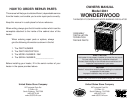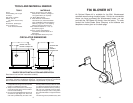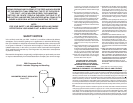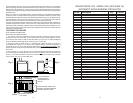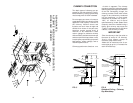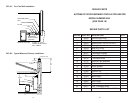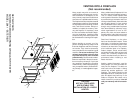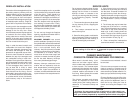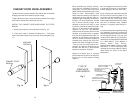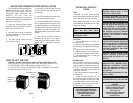
8
Install the stovepipe as far as possible
into the thimble, but not past the inside
of the flue lining. There should be a
small air space (approximately 1/2 in.)
between the stovepipe and thimble, al-
lowing for expansion of the stovepipe.
Seal this airspace with high-tempera-
ture caulking or ceramic wool. Finally,
be sure to wire the damper closed and
apply the same sealant you used at the
stovepipe and thimble junction.
Do not vent up through the fireplace
opening, regardless of whether the fire-
place opening is closed.
MASONRY CHIMNEY have several
positive attributes: If properly built, they
are quite durable, and most homeowners
consider them more attractive perhaps
than a non-enclosed factory built
chimney. And, if the chimney is located
within the confines of the house (that is,
not attached to an exterior wall), its
mass alone will store heat longer and
continue to release the heat long after
the fire has died. Masonry chimneys
have many disadvantages though.
Masonry chimneys constructed on an
exterior wall are exposed to cold out-
door temperatures, promoting greater
heater loss, higher accumulations of
creosote, and reduced draft which leads
to poorer heater or furnace performance.
FIREPLACE INSTALLATION
Connection of the stovepipe directly into
the existing masonry chimney over the
fireplace opening is the only approved
method. This installation performs bet-
ter, yielding easy to clean and inspect
for creosote. Before beginning this type
of installation plan carefully; a high de-
gree of skill is required to insure safety.
An entry port for the stovepipe must be
cut through the chimney with minimum
damage to the fire clay liner. Some
involved measurements may be required
to locate the flue liner exactly. Before
cutting, take time to mark the size and
position of the entry port. Position the
entry port so that at least 8 inches of the
flue liner remains below the port.
Keep in mind that wood mantels and
combustible trim around the fireplace
must have adequate clearances from
the heater and stovepipe or must be
protected in an approved manner. Also,
be sure to leave at least 24" clearance
between the top of the stovepipe and
the combustible ceiling or other com-
bustibles. Placing the center of the entry
port 2 feet below the ceiling will insure
proper clearance for 6 inch, 8 inch, and
10 inch stovepipes. Next, install a fire
clay (at least 5/8 in. thick) or metal
thimble, being sure that the thimble is
flush with the inner flue lining. Secure
the thimble in place with refractory mor-
tar. The thimble should be surrounded
on all sides with 8 inches of brickwork
(solid masonry units) or 24 inches of
stone.
CAUTION
A chimney fire may cause ignition of wall studs or rafters which you
thought were safe distance from the chimney. If you have a chimney fire,
have your chimney inspected by a qualified person before using again.
Do not expect a heater to draw. It is the
chimney that creates the draft. Smoke
spillage into the house or excessive
build-up of water or creosote in the
chimney are warnings that the chimney
is not functioning properly. Possible
causes are:
1. The connection pipe may be pushed
into the chimney too far, stopping the
draft (Fig. 8).
2. Two heaters connected into the
same chimney flue.
3. Same flue being used to ventilate the
cellar or basement. If there is a cleanout
opening at the base of the chimney, it
must be closed tightly and sealed.
4. If the chimney is too cool, water will
condense in the chimney and run back
into the stove. Creosote formation will
be rapid and may block the chimney.
Operate the heater at a high enough fire
to keep the chimney warm preventing
this condensation. (Poorly insulated
chimney)
5. The chimney top may be lower than
another part of the house or a nearby
tree. The wind blowing over a house or
a tree falls on top of the chimney like
water over a dam, beating down the
smoke. The top of the chimney should
be at least 3 feet higher than any point
of the roof within 10 feet (Fig. 6).
6. Other chimney/flue inadequacies
covered else where in this manual.
If creosote has accumulated, it should
be removed.
Failure to remove creosote or soot may
cause a house fire. Creosote may be
removed by using a chimney brush or
other commonly available materials. Or,
better yet, by a certified chimney sweep.
Chimney fires burn very hot. If the chim-
ney connector should glow red, immedi-
ately call the fire department, then re-
duce the fire by closing the inlet air
control and closing the damper in the
pipe.
CHIMNEY MAINTENANCE
CREOSOTE-FORMATION AND NEED FOR REMOVAL
NOTE:
A draft reading of .05 to .06 w.c. is suggested for proper burning of this
unit.
SERVICE HINTS
13
When wood is burned slowly, it pro-
duces tar and other organic vapors,
which combine with expelled moisture
to form creosote. The creosote vapors
condense in the relatively cool chimney
flue of a slow burning fire. As a result,
creosote residue accumulates on the
flue lining. When ignited, this creosote
makes an extremely hot fire.
The chimney connector and chimney
should be inspected at least twice
monthly during the heating season to
determine if a creosote build-up has
occurred.



